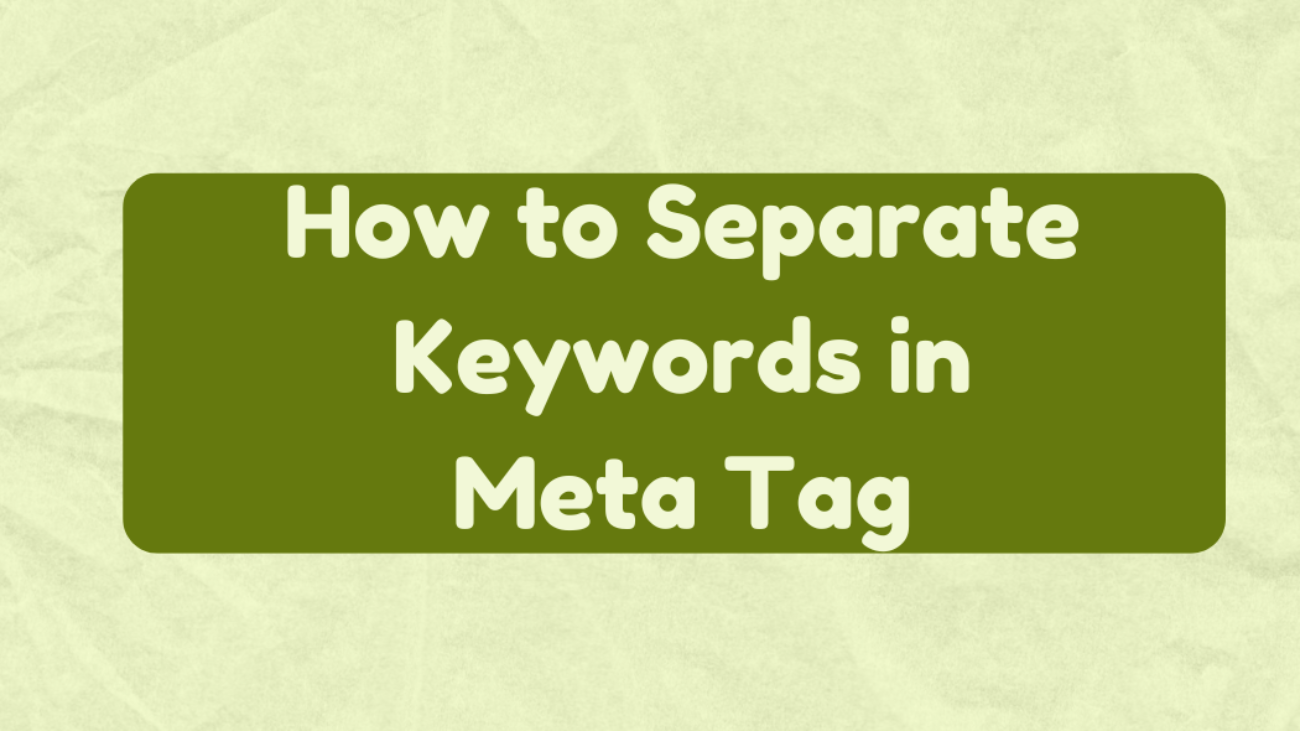In this post, we’ll look at the importance of meta keywords and how to separate keywords in meta tag for the best search engine optimization (SEO) outcomes.
Meta tags are important for search engine optimization (SEO) due to their ability to supply search engines with details regarding the content of a webpage.
The meta keywords tag is an important meta tag given that it helps search engines understand a web page’s core subjects and themes.
How To Separate Keywords In Meta Tag
Meta keywords are a form of meta tag that identifies the primary keywords or subjects of a web page’s content and here, we will explain how to separate keywords in meta tag
Meta keywords were important in the early days of SEO since they helped search engines comprehend and rank a page based on its content.
However, over time, search engines like Google and Yahoo began to ignore meta keywords due to their abuse by spammers and black hat SEO practitioners.
The use of commas does not affect the relevance of your web page. The search engines that employ the meta-tag keywords attribute don’t care if you split your keywords with commas or spaces.
If it is more convenient for you to view your keyword phrases with commas, use commas.
Although meta keywords can no longer be as important in search engine rankings nowadays, they can still be valuable for organizing and categorizing content on your website.
They are also capable of offering useful information to other search engines or platforms, which may still regard meta keywords as significant.
How to Improve SEO with Meta Tags
In contrast to popular assumption, SEO is more than just creating links and using high search volume keywords in your content.
Many more factors contribute to your website’s higher search rankings. Tags and meta tags are an important part of SEO.
Meta tags are tags in HTML that provide information about your web page’s content to search engines and visitors.
Essentially, these tags tell the search engine and users what the website is about.
1. Title tag:
The title is the first meta tag you’ll see on a webpage. It shows as a clickable headline on search engine results pages and provides a complete overview of your website’s content.
2. Meta Description:
Meta descriptions are located in the section of a web page and appear in the search engine result page (SERP) snippet with the title and URL of your webpage.
A meta description is the most important section of a SERP snippet. As a result, writing a catchy meta description increases your chances of attracting searchers to your site.
When you include the keywords that your potential visitors are looking for, they appear in the SERP in bold.
In this manner, you can make your search results stand out and let people know where to discover your page.
3. Header Tags:
Header tags are used to modify font sizes and identify a web page’s information structure.
These header tags range from H1 to H6, with H1 being the largest and H6 the smallest. Make it easy for consumers to consume the material while navigating the page.
Make it easier for search engines to grasp your material by organizing it using headings rather than a massive lump of information.
To score well in internet searches, a web page must include header tags.
4. Robots meta tag:
Robots meta tags are used to tell search engines whether or not to index a page. We also include this tag in the part of the web page.
The robot tag defines four settings for search engine crawlers:
Follow: This value instructs the search engine to follow all links on the webpage.
Nofollow: This value indicates that the search engine will not follow the page or its links.
Index: This value instructs the search engine to index the entire webpage.
NOINDEX: The search engine will not index the web page with this value.
5. Alternative text tags:
The alt text tag is intended to explain the content of a picture. It is significant since search engines cannot see images and rely on alt text to determine what the image is.
Aside from that, alt text tags provide users with information about the image if it fails to load for any reason.
Metadata For Search Engine Optimization
Meta tags and metadata are critical components of website SEO and search engine rankings.
They supply search engines with information about a webpage’s content and structure, thereby increasing a website’s visibility and accessibility.
Search Engine Optimization Meta-Description
A meta description is a summary of a webpage’s content, represented by an HTML description tag.
On a search engine results page (SERP), the meta description shows underneath the page title and URL.
It’s an important component of on-page SEO, therefore you should grasp how to optimize it.
These brief text snippets, usually 155-160 characters long, summarize a web page’s content and help search engines grasp its purpose and relevance.
Metadata Optimization
A meta description is a summary of a webpage’s content, represented by an HTML description tag.
On a search engine results page (SERP), the meta description shows underneath the page title and URL.
It is a critical component of on-page SEO, thus you need to grasp its optimization. Meta tags reside in the source code.
To view them in the browser, simply right-click and select “View Source” or “View Page Source”.
For specific circumstances, this strategy is highly useful. However, it takes a long time to load your full page.
In this scenario, you should have the entire website read out immediately.
This is especially easy with the right tools. They crawl rapidly and exhaustively, revealing which meta tags are absent, double, short, or long.
To maximize metadata, you must follow certain principles when creating it.
Existing titles and descriptions should also be assessed based on the following optimization ideas and tinkered with until they are purposeful and original.
Then you take care of any other missing meta tags so that after this stage, all indexed pages, title tags, and meta-descriptions, including assertiveness. on best practices.
Search Engine Optimization Meta-Tags
Meta tags are components that help search engines understand your content. These tags send information about your page to search engines and visitors. If you want to use meta tags efficiently, you should optimize them so that search engines can better index your content.
Meta Keywords Separator
While separating keywords in a meta tag may appear simple, there are complex ways to optimize your term utilization.
Hyphens, commas, and semicolons are examples of good keyword separation approaches. Experiment with various strategies and track their impact on your search engine rankings.
Conclusion
While meta keywords’ significance on search engine rankings has lessened, they can still provide useful information about your website’s content and increase its visibility.
When designing meta tags, it is important to consider several variables, including how to separate keywords in meta tag, the meta title tag, meta description tag, meta robots tag, and the use of social media meta tags.
Furthermore, including meta keywords naturally into your text and avoiding typical blunders will help you improve your SEO efforts.
By applying these tactics, you may improve your website’s search engine results, increase organic traffic, and maximize its potential. Contact our team for free consultation, if you need some help with you on-site optimisation.
Frequently Asked Questions
How to separate keywords in meta tag ?
Separate your keywords with a comma. Spaces are fine. The keyword meta tag was maybe useful.
Therefore, I would say you can spend time putting a comma after each keyword, or simply remove the keyword meta tag
How does metadata help a website?
Meta tags in HTML serve as important pieces of information for search engines.
They are used to describe HTML elements and communicate the content of a website for search engines.
Website metadata includes page titles, descriptions, keywords, and more to help search engines crawl and rank web pages.
What does meta name mean?
Meta is an original and standout name for girls. It has multiple sources across the globe, the main origin being German, where it means “pearl.
” As a Lithuanian name, Meta means “mint.” Meta is a Greek word meaning “beyond, after,” often associated with positive change, possibility, and evolution.


